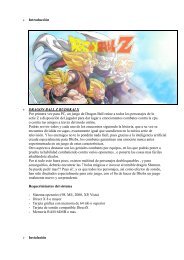Designing Games with Game Maker - YoYo Games
Designing Games with Game Maker - YoYo Games
Designing Games with Game Maker - YoYo Games
Create successful ePaper yourself
Turn your PDF publications into a flip-book with our unique Google optimized e-Paper software.
overwritten by the new path. (See a later chapter on how to create and<br />
destroy paths.) The function will return whether a path was found. The<br />
function will stop and report failure if no straight path exists between start and<br />
goal. If it fails a path is still created that runs till the position where the<br />
instance was blocked.<br />
mp_linear_path_object(path,xg,yg,stepsize,obj) Same as the<br />
function above but this time only instances of obj are considered as obstacles.<br />
obj can be an object or an instance id.<br />
mp_potential_path(path,xg,yg,stepsize,factor,checkall) This<br />
function computes a path for the instance from its current position and<br />
orientation to the position (xg,yg) using the indicated step size trying to avoid<br />
collision <strong>with</strong> obstacles. It uses potential field steps, like in the function<br />
mp_potential_step() and also the parameters that can be set <strong>with</strong><br />
mp_potential_settings(). The indicated path must already exist and will<br />
be overwritten by the new path. (See a later chapter on how to create and<br />
destroy paths.) The function will return whether a path was found. To avoid<br />
the function continuing to compute forever you need to provide a length factor<br />
larger than 1. The function will stop and report failure if it cannot find a path<br />
shorter than this factor times the distance between start and goal. A factor of<br />
4 is normally good enough but if you expect long detours you might make it<br />
longer. If it fails a path is still created that runs in the direction of the goal but<br />
it will not reach it.<br />
mp_potential_path_object(path,xg,yg,stepsize,factor,obj)<br />
Same as the function above but this time only instances of obj are considered<br />
as obstacles. obj can be an object or an instance id.<br />
The other functions use a much more complex mechanism using a grid-based approach<br />
(sometimes called an A* algorithm). It will be more successful in finding paths (although it still<br />
might fail) and will find shorter paths but it required more work on your side. The global idea<br />
is as follows. First of all we put a grid on (the relevant part of) the room. You can choose to<br />
use a fine grid (which will be slower) or a coarse grid. Next, for all relevant objects we<br />
determine the grid cells they overlap (either using bounding boxes or precise checking) and<br />
mark these cells as being forbidden. So a cell will be marked totally forbidden, even if it only<br />
partially overlaps <strong>with</strong> an obstacle. Finally we specify a start and a goal position (which must<br />
lie in free cells) and the function computes the shortest path (actually close to the shortest)






